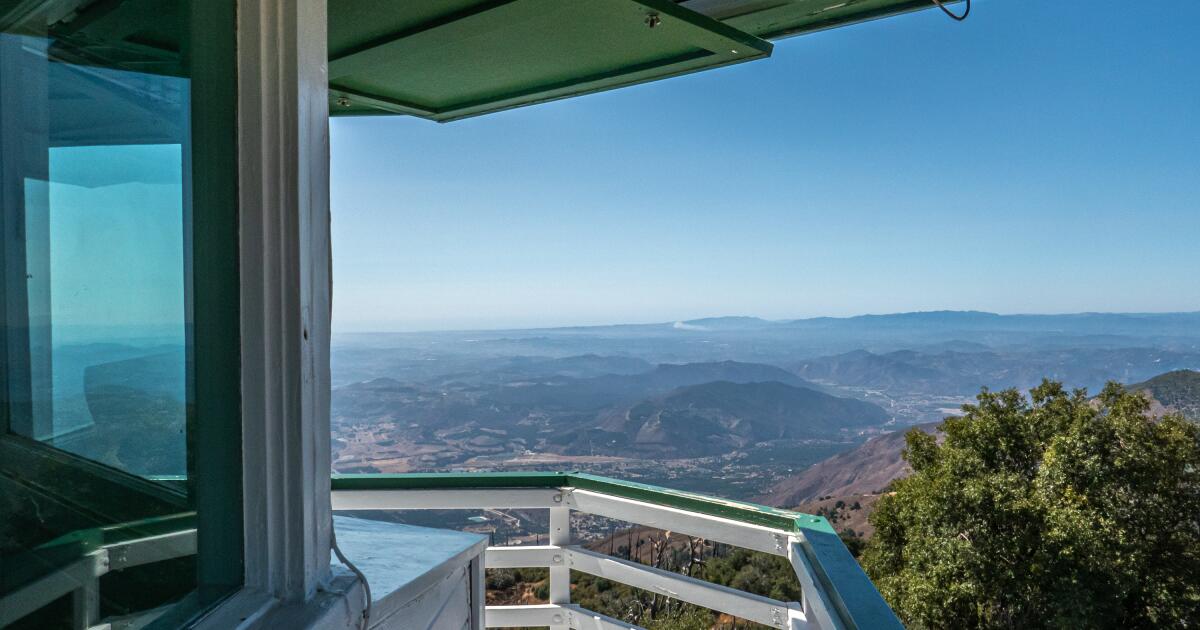
It was one of those special fall days when crystal-clear air allowed the eyes to see further than the imagination.
From my mile-high perch on the western nose of Palomar Mountain I could clearly see the sandstone cliffs of Catalina Island 80 miles to the west, and a cruise ship steaming into port in San Diego Bay, 50 miles to the south.
This was my 15th and final shift of the season as a volunteer fire lookout for the U.S. Forest Service and it was a glorious day in the Boucher Hill tower, located in Palomar Mountain State Park.
Fire season for lookouts begins May 1 and will close this year on Nov. 30, ending seven months of service by nearly 100 dedicated observers who staff both Boucher Hill and the High Point tower east of Palomar Observatory.
During that time, one or two lookouts in each tower keep a constant daylight vigil and made early reports of nearly 100 smokes sighted from Mexico into Riverside County and from the desert to the coast.
For those who follow my columns, I have frequently written about sit-and-see adventures that allow for greater insight into nature.
Spending time over seven months in a fire lookout is the ultimate sit and see.
Not only do you enjoy entire days in an elevated viewing platform surrounded by the activity of nature, but you are in the same place throughout spring, summer and fall, experiencing the subtle changes as the seasons progress.
My first tower shift was opening day of fire season on May 1.
The bright, spring-green leaves of the black oaks were just starting to fill out at the higher mountain elevations.
The most visible wildflowers were the large, white blossoms of the flowering dogwood along the state park road.
On morning drives to the tower, it was common to encounter flocks of wild turkey who often refused to yield the road, requiring me to stop until they decided to move on.
Several times I spotted an adult bobcat with twin kittens, and deer feeding in the fern meadows were a regular treat.

Bluebirds enjoy seed provided in a tray at the High Point Lookout on the east side of Palomar Mountain.
(Ernie Cowan / For The San Diego Union-Tribune)
As seasons evolved, flocks of western bluebirds arrived, a covey of quail with their fuzzy little chicks were regular visitors, and soaring hawks, ravens and bald eagles often buzzed the tower.
The grassy fields around the tower filled with grape soda lupine flowers, and the large, white blooms of Jimson weed dotted the forest floor.
The commanding views from the lookouts allows you to see oncoming weather or follow summer monsoons as they grow into distant thunderheads then dance about with the shifting winds.

A summer monsoon storm cell dropping intense rainfall. Lightning often accompanies this type of storm.
(Ernie Cowan / For The San Diego Union-Tribune)
The most exciting times are when those storms become angry, and the distant rumble of thunder is soon replaced by the powerful force of lightning striking all around the tower.
The lookout’s job is to mark those locations so they can be closely watched for several days in case a smoldering fire comes to life.
On those clear summer days, a lookout may be busy with visitors, or recording weather conditions, but is always watching for that tiny puff of distant smoke.
Using the Osborne Fire Finder, the lookout will quickly determine the direction, and using known landmarks get an estimated distance.
This information is radioed to dispatch along with a description of the smoke.
Within minutes, a combat force of engines, firefighters, aircraft, helicopters and bulldozers is on the way.
Often, the aircraft passing the tower will wing-wag to acknowledge our efforts, and the helicopters will sound a siren salute.
Yes, there are frantic moments of excitement in the lookouts, but also lots of quiet time to enjoy the beauty of nature.
Before lookouts went into service this year, I wrote a column about my excitement for the upcoming season.
Many readers responded, asking how they could become a volunteer fire lookout.

The view from inside the cab at High Point Lookout.
(Ernie Cowan / For The San Diego Union-Tribune)
As the season comes to an end, the Forest Fire Lookout Association is seeking more volunteers who would like to learn the skills and spend time next season enjoying the best views in Southern California while providing a valuable public service.
Volunteers attend three days of classroom training to learn about weather, fire behavior, radio procedures, safety and tower operations. To be certified, they must also complete three training shifts in each tower they want to work.
A master online calendar allows lookouts to schedule the times they would like to work throughout the season.
If you want to know more about next season’s training class, send your contact information to Shane Harris at fflatraining@gmail.com, no later than Jan. 20.
The changes of autumn are now in the air on the mountain.
Lookouts are finding chilly mornings, and the black oak leaves are fading to yellow, awaiting the winter winds that will set them free to flutter to earth.
Days are shorter and often visibility is limited by morning fog or a heavy marine layer.
Soon, towers will be shuttered as winter clouds, fog and snow come to the mountains.
Until spring, lookouts will have to be content seeing the best views with their imagination.
Cowan is a freelance columnist. Email ernie@packtrain.com or visit erniesoutdoors.blogspot.com.







